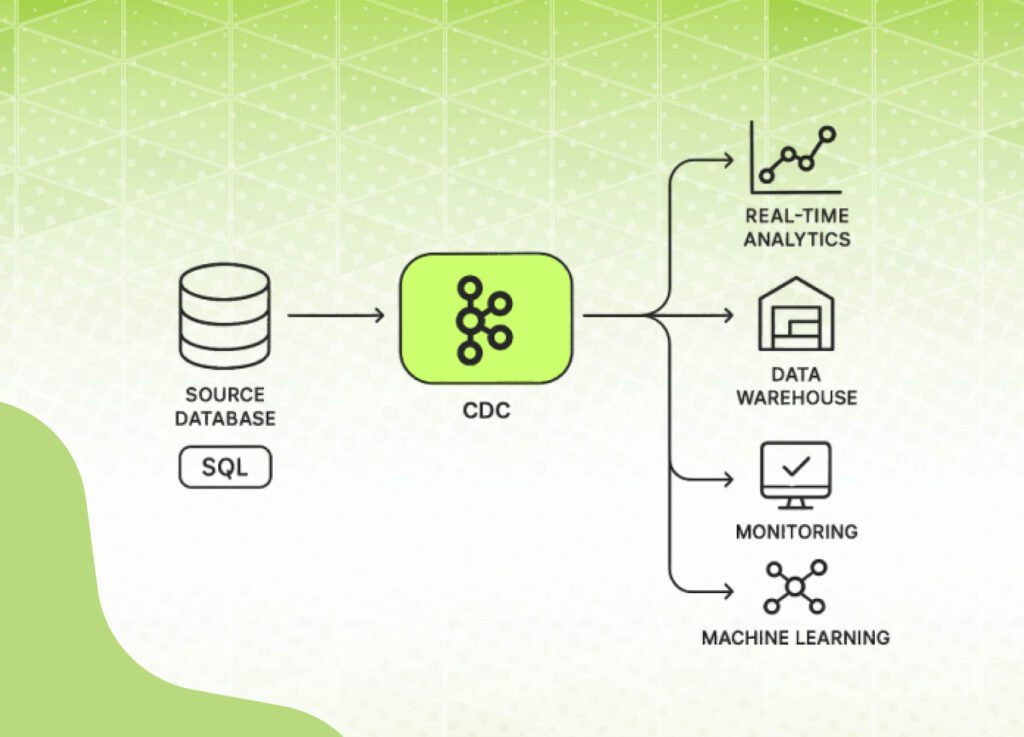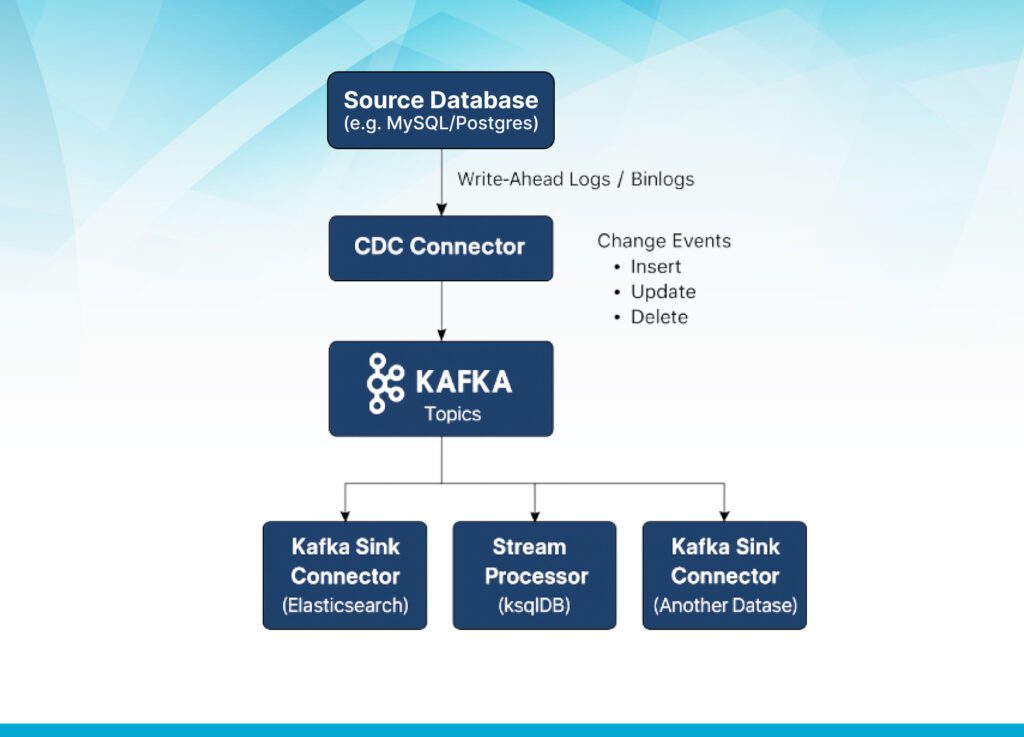|
Getting your Trinity Audio player ready...
|

Problem Statement
Before Change Data Capture (CDC), businesses relied on batch processing and full data replication to synchronize
databases. These traditional methods required extracting and copying entire datasets at scheduled intervals, which
introduced several inefficiencies:
- High Latency: Since batch processing occurred at predefined intervals, real-time updates were impossible,
leading to outdated information. - Unnecessary Data Transfers: Copying entire datasets resulted in excessive data movement, consuming
bandwidth and storage. - Heavy System Loads: Large-scale data replication strained database performance, slowing down other
operations. - Data Inconsistencies: Stale data led to mismatches between source and target systems, causing errors in
reporting and analytics.
As data volumes grew and businesses required real-time decision-making, these traditional approaches became
impractical. Change Data Capture (CDC) emerged as a solution, capturing only the changes (inserts, updates, deletes)
in real time. By reducing latency, minimizing data transfer, and improving accuracy, CDC revolutionized data
synchronization, making real-time integration feasible with minimal performance impact.
Introduction to Change Data Capture (CDC)
Change Data Capture (CDC) is a technology that identifies and tracks changes in a database in real time. Instead of
performing costly full-table scans, CDC captures only incremental changes, enabling faster and more efficient data
integration.
With CDC, businesses can:
- Ensure data consistency across multiple databases, data warehouses, and applications.
- Enable real-time analytics, allowing organizations to make faster, data-driven decisions.
- Support event-driven architectures by propagating changes as they occur.
CDC plays a critical role in modern data architectures, supporting industries like finance, healthcare, e-commerce,
and logistics that require real-time data synchronization.
How Change Data Capture Works

CDC continuously monitors a database for changes and propagates them to other systems. It can be implemented
using different techniques, each with its own strengths and trade-offs:
- Log-Based CDC (#ref)
- How it Works: Monitors the database’s transaction logs (binary logs, redo logs, or write-ahead logs) to track
changes. - Pros: Minimal overhead on the source database, real-time change detection, high efficiency.
- Cons: Requires database-level access to logs and a complex setup.
- Best for: Large-scale data integration, high-throughput applications.
- How it Works: Monitors the database’s transaction logs (binary logs, redo logs, or write-ahead logs) to track
- Trigger-Based CDC (#ref)
- How it Works: Uses database triggers to capture changes and store them in an audit table.
- Pros: Works across different database types, easy to implement.
- Cons: Adds processing overhead, can degrade performance on large datasets.
- Best for: Applications where log-based CDC is not an option.
- Query-Based CDC (#ref)
- How it Works: Periodically queries tables for changes based on timestamps or version numbers.
- Pros: Simple implementation, does not require database logs or triggers.
- Cons: High latency, increased database load, potential for missing changes.
- Best for: Low-volume data changes, systems without log access.
Why CDC is Essential for Modern Data Architectures
CDC is transforming how businesses handle data integration by providing several key advantages:
- Low Latency
- Traditional batch processing can take hours or even days.
- CDC enables real-time or near-real-time updates, ensuring up-to-date information.
- Improved Accuracy and Consistency
- Full-table replication can lead to inconsistencies.
- CDC maintains synchronization between source and target systems efficiently.
- Enhanced Scalability
- Avoids unnecessary data transfers, reducing strain on systems.
- Works efficiently even with high-volume transactional databases.
- Enables Real-Time Analytics and Event-Driven Architectures
- Businesses can analyze data as soon as it changes.
- Supports real-time dashboards, fraud detection, and personalized customer experiences.
Real-World Use Cases
CDC has diverse applications across industries, enabling businesses to leverage real-time data integration for
operational efficiency and decision-making:
- Finance
- Fraud detection by monitoring real-time transactions.
- Ensuring compliance with regulatory requirements through up-to-date financial records.
- Healthcare
- Keeping electronic health records (EHR) synchronized across hospitals, clinics, and insurers.
- Enabling real-time patient monitoring for critical care.
- E-Commerce and Retail
- Synchronizing inventory across multiple sales channels to prevent stockouts.
- Tracking real-time user activity for personalized recommendations.
- Logistics and Supply Chain
- Real-time tracking of shipments and deliveries.
- Dynamic route optimization based on live traffic and inventory levels.
Challenges and Best Practices in CDC Implementation
While CDC provides immense benefits, it also presents challenges that must be addressed:
- Handling Schema Changes
- Challenge: Changes in database schema (e.g., adding/removing columns) can break CDC pipelines.
- Best Practice: Implement schema evolution strategies like flexible data models (e.g., JSON storage) and
- schema versioning.
- Ensuring Data Consistency
- Challenge: Data loss or duplication during replication can lead to inconsistencies.
- Best Practice: Use idempotent operations, checkpointing mechanisms, and transactional guarantees.
- Optimizing Performance
- Challenge: CDC can impact database performance if not managed properly.
- Best Practice: Optimize CDC pipelines with efficient indexing, partitioning, and asynchronous processing.
- Security and Compliance
- Challenge: Real-time data movement increases exposure to security risks.
- Best Practice: Use encryption, access controls, and audit logging to ensure data security.
The Future of CDC
With advancements in AI and machine learning, CDC is evolving beyond simple change tracking. Future trends
include:
- Predictive CDC: AI-driven insights that anticipate changes before they happen.
- Automated Data Pipeline Optimization: Self-healing CDC pipelines that detect and resolve performance
bottlenecks. - Cloud-Native CDC: Seamless integration with serverless and microservices architectures.
- CDC for Streaming Analytics: Integration with event-driven frameworks like Apache Kafka for real-time data
processing.
As organizations continue to prioritize real-time data, CDC will remain a foundational technology for modern data-
driven applications.
Conclusion
Change Data Capture (CDC) is revolutionizing data integration by enabling real-time synchronization across systems.
By capturing only the changes instead of performing full data replication, CDC reduces latency, minimizes system
load, and ensures accurate data across platforms. From financial fraud detection to e-commerce inventory tracking,
CDC plays a vital role in driving business efficiency and innovation.
For businesses looking to enhance their data strategies, adopting CDC is no longer optional—it’s essential for staying
competitive in today’s fast-paced digital world.

